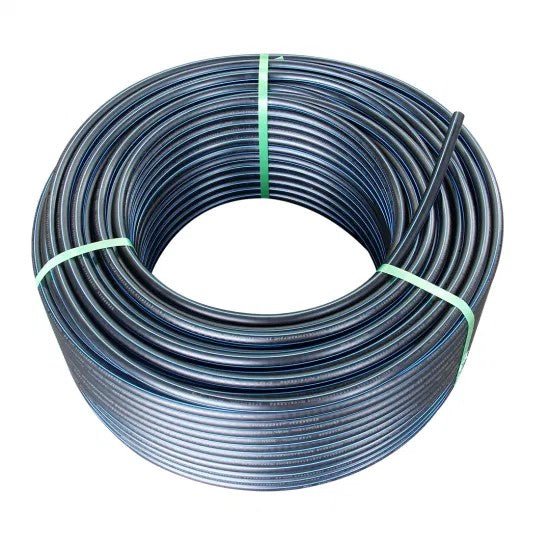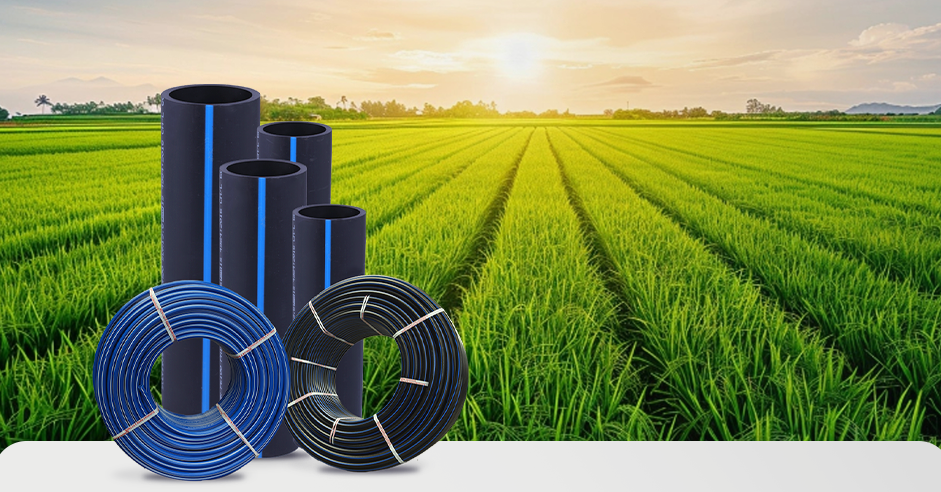Critical Benefits of custom hdpe pipe manufacturing Midland TX for Specialized Industries
Wiki Article
Check Out the Production Refine Behind High-Quality HDPE Pipe and Its Applications
The manufacturing process of top quality HDPE pipelines is detailed and systematic. It begins with the selection of raw materials that improve performance. Following this, ethylene goes through polymerization to form resin, which is then formed through extrusion. Quality assurance is vital, guaranteeing that the last product satisfies stringent requirements. The trip of HDPE pipelines doesn't finish with manufacturing. Their applications across different industries disclose a broader value worth checking out.Recognizing HDPE: Residences and Advantages

High-density polyethylene (HDPE) is a functional thermoplastic known for its sturdiness and resistance to various ecological variables. This material displays outstanding tensile stamina, making it ideal for requiring applications. Its low-density framework contributes to a lightweight item, promoting convenience of taking care of and setup. HDPE also showcases amazing resistance to chemicals, which minimizes destruction when revealed to rough compounds.
The material's low moisture absorption even more improves its longevity, making it suitable for use in pipelines and storage space containers. Furthermore, HDPE is immune to ultraviolet (UV) radiation, making certain that items keep their stability even when subjected to sunlight. Furthermore, its versatility permits the development of complex shapes without compromising toughness. The green nature of HDPE, often originated from recycled products, includes in its allure, advertising sustainable techniques in manufacturing. Generally, these residential properties and advantages make HDPE a preferred selection for numerous commercial and customer applications.
Basic Material Option for HDPE Manufacturing
The selection of resources for HDPE manufacturing is necessary to confirm the end product fulfills the wanted specs and quality criteria. High-density polyethylene (HDPE) is largely generated from polymerized ethylene, derived from nonrenewable fuel sources such as gas or petroleum. The top quality of these feedstocks significantly affects the mechanical and thermal residential or commercial properties of the final HDPE.Additives additionally play a substantial role in improving HDPE's efficiency, including antioxidants, UV stabilizers, and colorants, which enhance sturdiness and resistance to environmental aspects. The choice procedure need to consider not only the chemical composition of the raw products but also their processing attributes to ensure efficient manufacturing.
The sourcing of raw materials ought to focus on sustainability and compliance with environmental policies, as responsible methods are important in today's market. Inevitably, careful resources option lays the structure for creating top notch HDPE pipes appropriate for varied applications.
The Extrusion Process: Shaping HDPE Pipeline
The extrusion procedure plays a crucial function in shaping HDPE pipes, starting with thorough material preparation techniques that ensure ideal circulation and uniformity. Similarly crucial is the style of the die, which directly affects the final dimensions and surface high quality of the pipeline. Together, these elements add substantially to the effectiveness and high quality of HDPE pipeline manufacturing.Material Preparation Techniques
Efficient production of HDPE pipes starts with thorough material preparation methods, specifically the extrusion process. During this phase, high-density polyethylene resin is first dried to eliminate moisture, making certain suitable circulation qualities. The material is then fed right into the extruder, where it undergoes home heating and melting, transforming into a thick state. This home heating process is very carefully regulated to maintain the product's integrity and efficiency. The liquified HDPE is compelled through a die, forming it into a constant pipeline type. Proper temperature monitoring throughout extrusion is important, as it directly affects the material's buildings and the final product high quality. When formed, the HDPE pipe is cooled down and cut to defined lengths, all set for succeeding handling and applications.Die Layout Relevance
Accuracy in die style plays an important duty in the extrusion process of HDPE pipelines. The die functions as the final shaping device, straight influencing the pipe's dimensions, wall thickness, and surface finish. A properly designed die guarantees consistent material flow, reducing issues such as irregularities and weak spots. The geometry of the die need to be enhanced to accommodate the particular homes of HDPE, including its thickness and thermal habits throughout extrusion. Additionally, the cooling price of the material as it travels through the die can markedly impact the pipeline's architectural integrity. Spending in innovative die modern technology is vital for makers intending to produce high-quality HDPE pipelines that fulfill sector criteria and customer expectations.High Quality Control Measures in HDPE Manufacturing
Numerous elements affect the top quality of HDPE pipe production, efficient top quality control procedures are important to ensure consistency and integrity in the last item (custom hdpe pipe manufacturing Midland TX). Trick high quality control techniques include strenuous product inspection, confirming that the raw polyethylene meets well established requirements for pureness and density. During the extrusion procedure, criteria such as temperature, pressure, and cooling time are closely kept an eye on to maintain dimensional accuracy and structural integrityOn top of that, post-production testing is necessary; manufacturers often conduct hydrostatic examinations to evaluate the pipeline's stamina and resistance to pressure. Aesthetic evaluations for surface area problems further boost quality guarantee. Qualification from relevant requirements organizations, like ASTM or ISO, offers an additional layer of integrity. By executing these complete quality assurance actions, suppliers can lessen flaws, boost performance, and ensure that the HDPE pipes meet the certain needs of different applications, ultimately bring about consumer fulfillment and depend on in the item.
Applications of HDPE Pipeline Throughout Industries
HDPE pipes are utilized across various industries because of their toughness and versatility. In water distribution systems, they ensure effective distribution, while in wastewater monitoring, they supply trustworthy services for waste transport. In addition, agricultural watering networks gain from HDPE's resistance to rust and versatility, making it a perfect choice for modern-day farming practices.
Water Distribution Equipments
A considerable variety of sectors rely upon high-density polyethylene (HDPE) pipelines for efficient water distribution systems. Known for their longevity and resistance to rust, HDPE pipelines are widely made use of in community supply of water networks, farming irrigation, and industrial applications. Their light-weight nature promotes very easy handling and setup, lowering labor costs and time. Additionally, HDPE pipes visit can accommodate different pressure levels, making them suitable for both low and high-pressure systems. hdpe pipe suppliers Midland TX. The flexibility of the product enables smooth assimilation into existing framework, lessening the demand for comprehensive excavation. Furthermore, HDPE's resistance to chemical leaching warranties that the water provided remains secure and clean, making it a perfect choice for maintaining the high quality of safe and clean water across numerous sectorsWastewater Management Solutions
Efficient water distribution systems likewise lead the way for innovative wastewater administration solutions, where high-density polyethylene (HDPE) pipes play a significant function. Prominent for their sturdiness and resistance to corrosion, HDPE pipes are excellent for transporting wastewater in various settings. Their adaptability enables very easy installation in intricate settings, lessening the demand for substantial excavation. Furthermore, HDPE's smooth interior surface area reduces rubbing, improving circulation rates and effectiveness. These pipes are also immune to chemical leaching, ensuring that impurities do not compromise the surrounding environment. Industries, communities, and treatment facilities increasingly count on HDPE pipes for their integrity and durability, making them a favored selection for contemporary wastewater management systems. This flexibility emphasizes the vital importance of HDPE pipelines throughout numerous applications.Agricultural Irrigation Networks
Agricultural irrigation networks benefit substantially from using high-density polyethylene (HDPE) pipes, which offer efficient and reputable water shipment to plants. HDPE pipes are lightweight, making them easy to transport and install, while their flexibility allows for various arrangements in diverse surfaces. These pipelines show outstanding resistance to rust, chemicals, and UV radiation, making certain toughness in severe agricultural atmospheres. Furthermore, their smooth indoor surface area reduces rubbing loss, enhancing water flow and minimizing power expenses connected with pumping. The long life of HDPE pipelines, commonly surpassing 50 years, adds to decrease upkeep and substitute expenses. Farmers increasingly rely on HDPE pipes to enhance watering efficiency and promote lasting agricultural practices, eventually leading to boosted plant returns and source preservation.
Future Patterns in HDPE Pipe Modern Technology
As the need for sustainable and efficient facilities expands, advancements in HDPE pipeline technology are poised to change various industries. Arising trends consist of the assimilation of wise technologies, such as sensors and IoT capabilities, which facilitate real-time monitoring of pipeline conditions, decreasing maintenance expenses and stopping leaks. Furthermore, the advancement of sophisticated manufacturing methods, such as 3D printing, is making it possible for the production of facility, personalized pipe designs that satisfy specific project requirements.The focus on recycling and circular economic situation methods is driving the innovation of HDPE pipelines made from recycled products, boosting sustainability. Boosted jointing methods, such as electro-fusion and mechanical installations, are also boosting installation effectiveness and reliability. Ultimately, the expanding emphasis on environmental policies is pressing producers to adopt greener production procedures, ensuring that HDPE pipelines not just meet industry standards yet likewise promote an even more lasting future for framework growth.
Often Asked Inquiries
How Does HDPE Contrast to Other Plastic Products?
HDPE exceeds lots of various other plastic products relating to sturdiness, chemical resistance, and flexibility. Its reduced density and high tensile toughness irrigation hose connector make it ideal for various applications, often exceeding alternatives in both performance and durability.What Are the Environmental Effects of HDPE Production?
The ecological influences of HDPE production consist of greenhouse gas discharges, power intake, and prospective pollution from manufacturing procedures. Additionally, inappropriate disposal can bring about soil and water contamination, raising worries concerning lasting my review here environmental impacts.Can HDPE Pipes Be Recycled?
Yes, HDPE pipes can be recycled. Many centers accept used HDPE for processing, transforming it into new items. This recycling adds to sustainability initiatives, lowering plastic waste while preserving resources and power in the manufacturing cycle.What Is the Lifespan of HDPE Piping?

Just How Do Temperature Level Variations Affect HDPE Pipeline Efficiency?
Temperature variations substantially impact HDPE pipe efficiency, affecting flexibility and stamina. Heats can bring about softening, while reduced temperatures may create brittleness, inevitably affecting the pipe's resilience and suitability for different applications in diverse settings.Report this wiki page